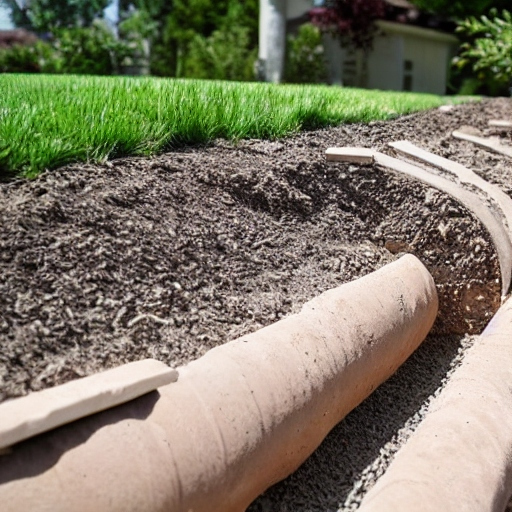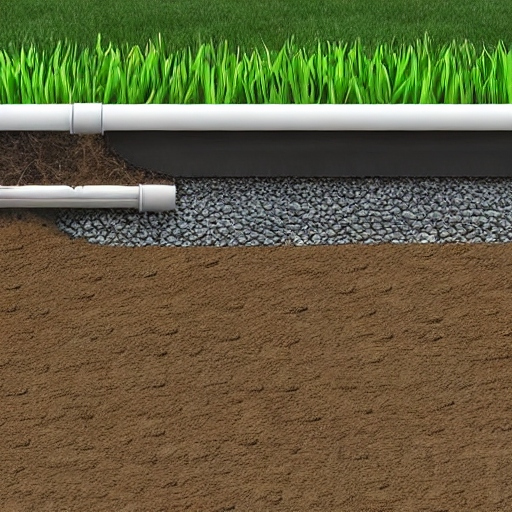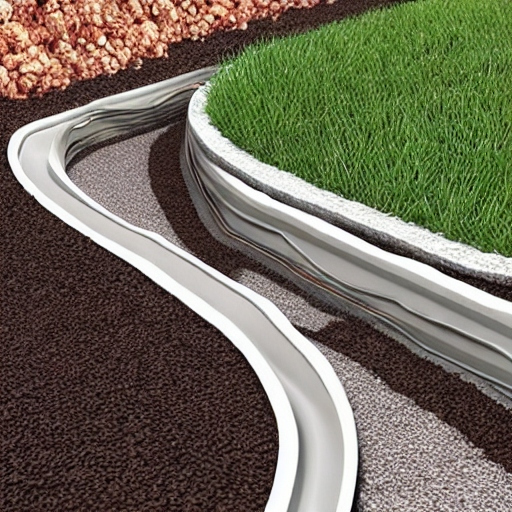French drain is a powerful force of nature that can wreak havoc on our outdoor spaces. From flooding events to waterlogged gardens, dealing with excess water is a common challenge for many homeowners., there is a solution that stands the test of time – the French drain.
In this article, we will explore the concept, benefits, installation process, and maintenance of French drains. By the end, you’ll have all the knowledge you need to make informed decisions about how to tackle water-related problems on your property.
The Basics of a French Drain
A French drain, also known as a weeping tile or sub-surface drain, is a drainage system designed to redirect water away from a specific area.
It consists of a perforated pipe, surrounded by gravel or rock, and is covered with a layer of landscape fabric to prevent soil from entering and clogging the system.
This combination of materials creates a pathway for water to flow freely, preventing it from pooling or damaging structures.
How Does it Work?
When water encounters the French drain, it enters through the small openings on the perforated pipe. From there, it seeps into the surrounding gravel or rock, drains away from the area, and exits safely elsewhere.
This efficient design relieves hydrostatic pressure, diverts water away from vulnerable spots, and helps prevent water-related damage.
French drains usually include filters to prevent soil from entering the drainage system and maintain drain efficiency. Envelopes, usually made of geotextile fabric, surround the drain pipe within the gravel to prevent blockage while allowing water to pass through.
These components help manage water flow while preventing soil and debris from obstructing the drain.
Benefits of Installing a French Drain
Installing a French drain comes with a host of benefits, making it a worthy investment for homeowners dealing with water issues. Let’s explore some of the key advantages:
1. Effective Waterproofing Solution
French drains are highly effective at managing excess water, whether it’s surface runoff, groundwater, or water flowing downhill.
By redirecting water away from your property’s foundation, basement, or vulnerable landscaping, you can prevent water damage, mold growth, and structural issues.
2. Versatility and Flexibility
French drains are versatile and can be implemented in various circumstances. Whether you’re dealing with a soggy yard, or a wet basement, or need proper drainage for your garden, a French drain can be customized to fit your specific needs.
3. Cost-Effective Solution
Compared to other drainage solutions, a French drain is a cost-effective option that can potentially save you money in the long run. By preventing costly water damage repairs, you’ll have peace of mind knowing that your investment will pay off in the form of a dry, well-maintained property.

French Drain Cost
French drain cost per foot and installation of a French drain can vary widely depending on several factors, including the type of drain, the scope of the project, and the characteristics of the property. However, here is an approximate breakdown of costs for a typical French drain installation:
- Materials:
- Perforated Pipe: $0.50 – $2.00 per linear foot.
- Gravel or Stone: $30 – $50 per cubic yard.
- Geotextile Fabric: $0.30 – $0.50 per square foot.
- Labor:
- Installation costs depend on labor rates and the complexity of the project, ranging from $20 to $50 per linear foot.
- Excavation and Equipment:
- Equipment rental or excavation costs may vary between $500 and $1,500 or more, depending on the project’s size and depth.
- Other Expenses:
- Permit fees, additional supplies, and the need for professional consultation can increase the total cost.
Overall, the total cost of installing a French drain can range from a few hundred to several thousand dollars, depending on the specific requirements and any additional factors that might affect the installation process.
Consulting with professionals and obtaining quotes is recommended to get an accurate estimate for your particular project.
| Cost Components | Estimated Range |
|---|---|
| Perforated Pipe | $0.50 – $2.00 per linear foot |
| Gravel/Stone | $30 – $50 per cubic yard |
| Geotextile Fabric | $0.30 – $0.50 per sq. foot |
| Labor | $20 – $50 per linear foot |
| Excavation/Equipment | $500 – $1,500+ |
| Additional Expenses | Varies |
Installing a French Drain
1. Planning and Design
Before diving into the installation process, it’s crucial to plan and design the French drain system properly. Consider the layout of your property, the natural flow of water, and any potential obstructions.
It’s recommended to consult with a professional to ensure the drainage system is designed to meet your specific needs.
2. Excavation
Once the design is finalized, the first step of installation involves marking and excavating the area where the French drain will be placed. This requires digging a trench to the appropriate depth and width, ensuring it slopes slightly to promote water flow.
3. Adding Gravel and Pipe Placement
With the trench in place, a layer of gravel or crushed stone is added to the bottom to facilitate water drainage. Subsequently, the perforated pipe is placed on top of the gravel, ensuring the small holes face downwards to allow water entry.
4. Covering and Backfilling
After the pipe is securely positioned, it is covered with an additional layer of gravel or rock. This helps to further promote water filtration and prevent soil intrusion.
Finally, the trench is backfilled with the excavated soil, and the excess surface soil is leveled to restore the aesthetic appeal of the area.

Maintaining a French Drain
Once your French drain is installed, proper maintenance is essential to ensure its longevity and effectiveness. Here are some maintenance tips to keep in mind:
- Regularly inspect the drain for any signs of clogging, such as excessive debris, roots, or sediment buildup.
- Clean the drain and remove any obstructions to maintain proper water flow.
- Check the landscape fabric periodically and replace it if damaged or clogged to prevent soil from entering the system.
- Keep the surrounding area well-maintained by trimming vegetation and preventing the accumulation of leaves or debris that may obstruct the drain.
“Remember, routine maintenance is the key to ensuring your French drain functions optimally year after year.”
Types of French Drains
- Traditional French Drain: Constructed with a perforated pipe installed in a gravel-filled trench. It’s designed to redirect water away from the desired area.
- Trenchless French Drain: Employing innovative methods like directional boring or pipe bursting to install the drain without extensive trench excavation.
- Exterior French Drain: Installed outside the building or foundation to divert water away from the structure, preventing seepage or dampness.
- Interior French Drain: Positioned inside the building’s foundation to address basement or crawl space water issues, redirecting water to a sump pump.
- Dry Well French Drain: Diverts water to an underground dry well where it’s stored or allowed to percolate gradually into the ground.
- Curtain Drain: Utilized in areas with surface water issues. It’s installed uphill to intercept and divert water away from the problematic area.
- Dispersal French Drain: Distributes collected water into multiple channels, preventing saturation in a single location.
- French Soakaway Drain: Similar to a dry well, it allows water to disperse and infiltrate the surrounding soil.
French Drain Mistakes
- Insufficient Slope: Failure to provide adequate slope in the drain. It should usually slope at least 1% away from the problem area to enable water flow.
- Use of improper gravel or stone: Using the wrong size or type of gravel or stone can hinder drainage or prevent the system from working optimally.
- Fabric or Geotextile Neglect: Using fabric or geotextiles to prevent soil infiltration and sediment build-up within the drain.
- Insufficient depth: Installing the drain too shallow will prevent water from being adequately collected and redirected away from the targeted area.
- Bad pipe connection: Connecting pipes incorrectly or neglecting proper connections can cause leaks or blockages, affecting drain efficiency.
- Insufficient System Length: Failure to install an adequate length of a French drain may limit its water distribution capabilities.
- Ignoring the exit point: Not planning or designing an effective outlet point for drains can cause water to accumulate near the foundation.
- Neglecting Perforated Pipe Position: Improper installation of perforated pipes can cause water accumulation or limit water absorption.
- Wrong backfilling: Filling the trench incorrectly with soil that does not drain effectively or compacting soil too tightly around the system can impede water flow.
- Ignoring local rules: Not following local building codes or regulations may result in violations and hinder the effectiveness of the drainage system.
Consulting with professionals or following guidelines can help prevent these errors and ensure successful installation.
French Drain Without Pipe
A French drain, also without pipes, operates using the same principle as its conventional counterpart. It involves setting up a trench filled with gravel or rock, allowing water to flow through the ground and enter the gravel-filled trench.
Water is then directed away from a specific area, such as the foundation or other water-sensitive areas.
While a French drain without pipes can be effective in some circumstances, its efficacy can vary depending on factors such as soil type, drainage requirements, and the amount of water to be redirected.
The absence of pipes may limit the ability of the drain to move water away quickly and result in slower drainage or less effective water diversion. It is advisable to consult a professional to determine the drainage solution most appropriate for your specific situation.

Conclusion
French drains are a versatile and effective solution for managing excess water on your property. By redirecting water away from vulnerable areas, they help prevent costly water damage, maintain structural integrity, and create a dry and safe environment.
With proper planning, installation, and maintenance, a French drain can be your go-to solution for water-related issues, offering you peace of mind and a well-maintained property for years to come.
People Also Ask
- How does a French drain system work?
- A French drain directs water away using a gravel-filled trench and a perforated pipe. Water is collected by the pipe and diverted away from the problem area.
- Is a French drain a good idea?
- Yes, French drains are effective for managing water flow, preventing flooding, and protecting structures from water damage.
- What is the purpose of French drains?
- The primary purpose is to manage water drainage by redirecting it away from areas prone to pooling or water damage.
- Why is it called a French drain?
- Named after Henry French, the creator, it gained popularity as an effective water drainage solution.
- Difference between a French drain and a regular drain?
- A French drain is a trench system filled with gravel and a pipe to redirect water, while regular drains collect water for disposal without redirecting it away.

